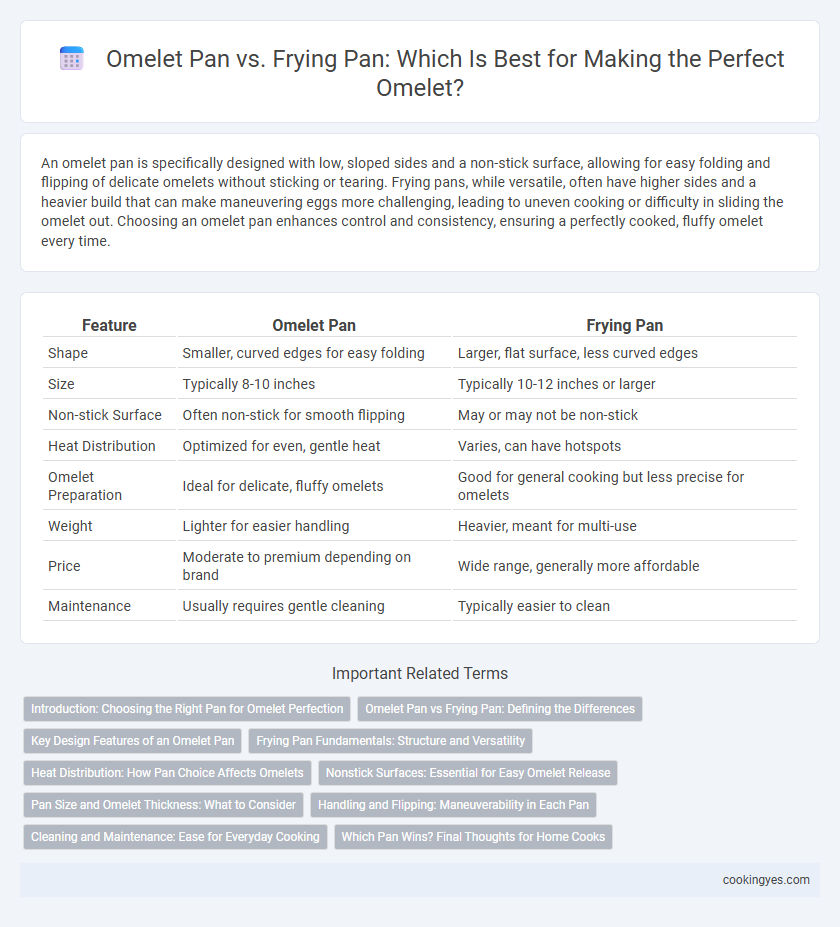An omelet pan is specifically designed with low, sloped sides and a non-stick surface, allowing for easy folding and flipping of delicate omelets without sticking or tearing. Frying pans, while versatile, often have higher sides and a heavier build that can make maneuvering eggs more challenging, leading to uneven cooking or difficulty in sliding the omelet out. Choosing an omelet pan enhances control and consistency, ensuring a perfectly cooked, fluffy omelet every time.
Table of Comparison
| Feature | Omelet Pan | Frying Pan |
|---|---|---|
| Shape | Smaller, curved edges for easy folding | Larger, flat surface, less curved edges |
| Size | Typically 8-10 inches | Typically 10-12 inches or larger |
| Non-stick Surface | Often non-stick for smooth flipping | May or may not be non-stick |
| Heat Distribution | Optimized for even, gentle heat | Varies, can have hotspots |
| Omelet Preparation | Ideal for delicate, fluffy omelets | Good for general cooking but less precise for omelets |
| Weight | Lighter for easier handling | Heavier, meant for multi-use |
| Price | Moderate to premium depending on brand | Wide range, generally more affordable |
| Maintenance | Usually requires gentle cleaning | Typically easier to clean |
Introduction: Choosing the Right Pan for Omelet Perfection
Omelet pans are specifically designed with non-stick surfaces and rounded edges to facilitate easy flipping and folding, ensuring a perfectly cooked omelet every time. Frying pans, while versatile, may lack the optimal shape and non-stick properties needed for delicate omelet preparation, resulting in uneven cooking or sticking. Selecting an omelet pan enhances heat distribution and control, crucial factors for achieving the ideal texture and consistency in omelet recipes.
Omelet Pan vs Frying Pan: Defining the Differences
Omelet pans are specifically designed with a non-stick surface and a slightly curved edge to facilitate easy flipping and folding of omelets, while frying pans often have flatter sides better suited for a variety of cooking tasks. The size and shape of an omelet pan, typically smaller and lighter than a frying pan, allow for better control and even heat distribution crucial for perfect omelet texture. Material differences, such as anodized aluminum or stainless steel in omelet pans, contribute to superior heat conduction compared to some frying pans, optimizing the omelet cooking process.
Key Design Features of an Omelet Pan
Omelet pans feature a smaller diameter, typically 8 to 10 inches, with gently sloped sides designed to facilitate easy folding and flipping of delicate omelets without breaking. They often have a non-stick coating to prevent sticking and ensure smooth release, along with a lightweight design for better maneuverability. Compared to larger, flat frying pans, omelet pans provide optimal control and heat distribution specific to omelet preparation.
Frying Pan Fundamentals: Structure and Versatility
A frying pan features a flat bottom with slightly sloped sides, designed for even heat distribution and easy food turning, making it ideal for various cooking techniques including sauteing, searing, and frying. Constructed from materials like stainless steel, cast iron, or non-stick coatings, frying pans offer durability and adaptability across stovetop heat sources. This versatile structure allows cooks to prepare omelets with precise heat control and ample space for folding or adding fillings.
Heat Distribution: How Pan Choice Affects Omelets
Omelet pans are specifically designed with thicker, more even heat distribution, preventing hot spots that can cause uneven cooking or burning. Frying pans often have thinner bases, leading to inconsistent heat and difficulty in achieving the delicate texture of a perfect omelet. Choosing an omelet pan ensures balanced heat control, resulting in smooth, fluffy omelets with consistent browning.
Nonstick Surfaces: Essential for Easy Omelet Release
Nonstick surfaces in omelet pans provide superior ease of egg release, preventing sticking and maintaining the omelet's delicate texture. Frying pans, unless specifically coated with high-quality nonstick materials, often cause eggs to adhere, complicating flipping and presentation. Investing in an omelet pan with a durable nonstick coating enhances cooking efficiency and preserves the omelet's integrity.
Pan Size and Omelet Thickness: What to Consider
Choosing the right pan size is crucial for achieving the desired omelet thickness; smaller pans concentrate heat and create thicker omelets, while larger pans allow for thinner, evenly cooked eggs. Omelet pans are typically designed with sloped sides and non-stick surfaces to facilitate easy flipping and folding, enhancing control over thickness compared to standard frying pans. For best results, a 8 to 10-inch omelet pan balances pan size with omelet thickness, ensuring consistent heat distribution and optimal cooking performance.
Handling and Flipping: Maneuverability in Each Pan
Omelet pans are specifically designed with lighter materials and non-stick surfaces, enhancing maneuverability for smooth handling and easy flipping of delicate omelets. Frying pans, while versatile, often have heavier construction and less specialized shapes, which can make flipping omelets more challenging and increase the risk of breaking. The rounded edges and optimal depth of omelet pans facilitate gentle sliding and precise control, ensuring perfect omelet folds without sticking or tearing.
Cleaning and Maintenance: Ease for Everyday Cooking
Omelet pans feature non-stick surfaces designed specifically for easy release of eggs, making cleaning quick and effortless compared to traditional frying pans that often require more scrubbing. The typically smaller size and lightweight nature of omelet pans also aid in simpler maintenance and storage after everyday use. Frying pans may retain food residue and oil stains more stubbornly, increasing cleaning time and effort in routine omelet preparation.
Which Pan Wins? Final Thoughts for Home Cooks
Non-stick omelet pans outperform traditional frying pans by ensuring even heat distribution and effortless flipping, crucial for achieving a fluffy, well-cooked omelet. Omelet pans typically feature sloped sides and a smaller diameter, providing better control when folding and sliding the omelet onto a plate. For home cooks seeking precision and consistent results, investing in a quality omelet pan is the optimal choice.
Omelet Pan vs Frying Pan for omelet preparation Infographic

 cookingyes.com
cookingyes.com